Categories and Categorization类别与分类
- 格式:ppt
- 大小:2.32 MB
- 文档页数:39
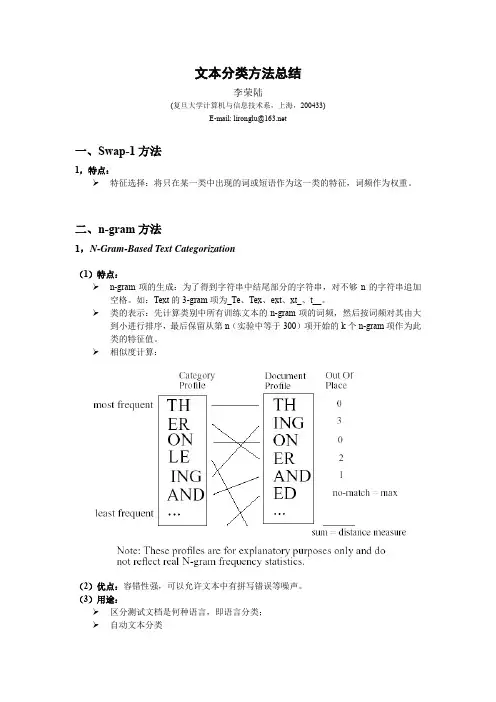
文本分类方法总结李荣陆(复旦大学计算机与信息技术系,上海,200433)E-mail: lironglu@一、Swap-1方法1,特点:特征选择:将只在某一类中出现的词或短语作为这一类的特征,词频作为权重。
二、n-gram方法1,N-Gram-Based Text Categorization(1)特点:n-gram项的生成:为了得到字符串中结尾部分的字符串,对不够n的字符串追加空格。
如:Text的3-gram项为_Te、Tex、ext、xt_、t__。
类的表示:先计算类别中所有训练文本的n-gram项的词频,然后按词频对其由大到小进行排序,最后保留从第n(实验中等于300)项开始的k个n-gram项作为此类的特征值。
相似度计算:(2)优点:容错性强,可以允许文本中有拼写错误等噪声。
(3)用途:区分测试文档是何种语言,即语言分类;自动文本分类2,CAN Bayes(Chain Augmented Naive Bayes)Bayes 分类器是一个性能很好的线性分类器,但是它假设文档的每个分类特征属性间是相互独立的,这显然是不成立的。
假设d i ={w i1,w i2,…,w in }为一任意文档,它属于文档类C ={c 1, c 2,…, c k }中的某一类c j 。
根据Bayes 分类器有:)()|()()()|()|(j j i i j j i i j c P c d P d P c P c d P d c P ∝=,其中∏==rk j ik j i c w P c d P 1)|()|(。
如果使用Bayes 网络来描述特征属性间的联系,则失去了Bayes 模型的简单性和线性特征。
我们使用了统计语言学中的N-Gram 模型,它假设一个词在文档中某个位置出现的概率仅与它之前的n-1个词有关,即:)|()|(11121--+--=i n i n i i i i w w w w P w w w w P 。
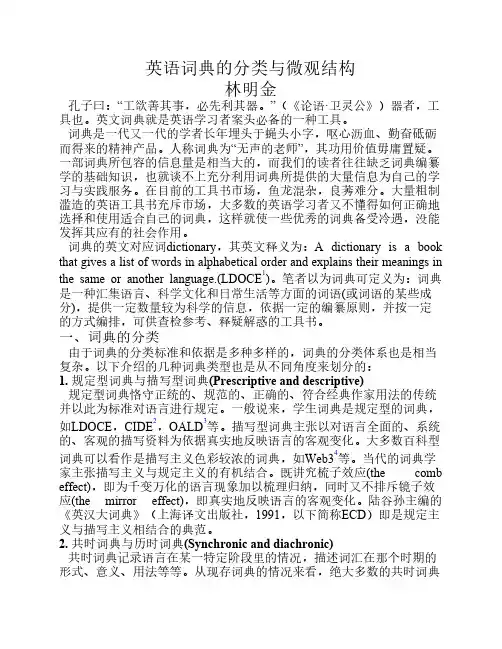
英语词典的分类与微观结构林明金孔子曰:“工欲善其事,必先利其器。
”(《论语·卫灵公》)器者,工具也。
英文词典就是英语学习者案头必备的一种工具。
词典是一代又一代的学者长年埋头于蝇头小字,呕心沥血、勤奋砥砺而得来的精神产品。
人称词典为“无声的老师”,其功用价值毋庸置疑。
一部词典所包容的信息量是相当大的,而我们的读者往往缺乏词典编纂学的基础知识,也就谈不上充分利用词典所提供的大量信息为自己的学习与实践服务。
在目前的工具书市场,鱼龙混杂,良莠难分。
大量粗制滥造的英语工具书充斥市场,大多数的英语学习者又不懂得如何正确地选择和使用适合自己的词典,这样就使一些优秀的词典备受冷遇,没能发挥其应有的社会作用。
词典的英文对应词dictionary,其英文释义为:A dictionary is a book that gives a list of words in alphabetical order and explains their meanings in the same or another language.(LDOCE1)。
笔者以为词典可定义为:词典是一种汇集语言、科学文化和日常生活等方面的词语(或词语的某些成分),提供一定数量较为科学的信息,依据一定的编纂原则,并按一定的方式编排,可供查检参考、释疑解惑的工具书。
一、词典的分类由于词典的分类标准和依据是多种多样的,词典的分类体系也是相当复杂。
以下介绍的几种词典类型也是从不同角度来划分的:1. 规定型词典与描写型词典(Prescriptive and descriptive)规定型词典恪守正统的、规范的、正确的、符合经典作家用法的传统并以此为标准对语言进行规定。
一般说来,学生词典是规定型的词典,如LDOCE,CIDE2,OALD3等。
描写型词典主张以对语言全面的、系统的、客观的描写资料为依据真实地反映语言的客观变化。
大多数百科型词典可以看作是描写主义色彩较浓的词典,如Web34等。
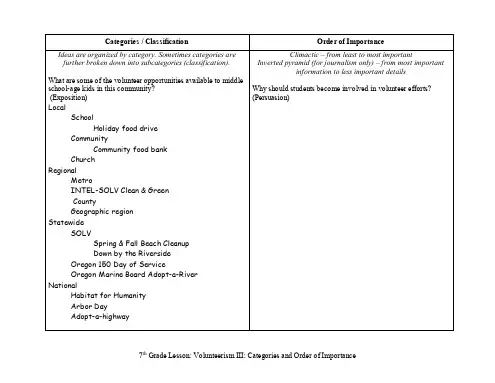
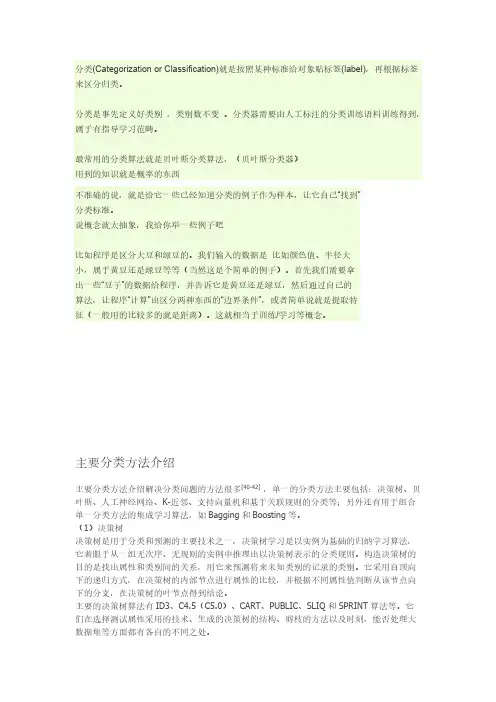
分类(Categorization or Classification)就是按照某种标准给对象贴标签(label),再根据标签来区分归类。
分类是事先定义好类别,类别数不变。
分类器需要由人工标注的分类训练语料训练得到,属于有指导学习范畴。
最常用的分类算法就是贝叶斯分类算法,(贝叶斯分类器)用到的知识就是概率的东西不准确的说,就是给它一些已经知道分类的例子作为样本,让它自己“找到”分类标准。
说概念就太抽象,我给你举一些例子吧比如程序是区分大豆和绿豆的。
我们输入的数据是比如颜色值、半径大小,属于黄豆还是绿豆等等(当然这是个简单的例子)。
首先我们需要拿出一些“豆子”的数据给程序,并告诉它是黄豆还是绿豆,然后通过自己的算法,让程序“计算”出区分两种东西的“边界条件”,或者简单说就是提取特征(一般用的比较多的就是距离)。
这就相当于训练/学习等概念。
主要分类方法介绍主要分类方法介绍解决分类问题的方法很多[40-42],单一的分类方法主要包括:决策树、贝叶斯、人工神经网络、K-近邻、支持向量机和基于关联规则的分类等;另外还有用于组合单一分类方法的集成学习算法,如Bagging和Boosting等。
(1)决策树决策树是用于分类和预测的主要技术之一,决策树学习是以实例为基础的归纳学习算法,它着眼于从一组无次序、无规则的实例中推理出以决策树表示的分类规则。
构造决策树的目的是找出属性和类别间的关系,用它来预测将来未知类别的记录的类别。
它采用自顶向下的递归方式,在决策树的内部节点进行属性的比较,并根据不同属性值判断从该节点向下的分支,在决策树的叶节点得到结论。
主要的决策树算法有ID3、C4.5(C5.0)、CART、PUBLIC、SLIQ和SPRINT算法等。
它们在选择测试属性采用的技术、生成的决策树的结构、剪枝的方法以及时刻,能否处理大数据集等方面都有各自的不同之处。
(2)贝叶斯贝叶斯(Bayes)分类算法是一类利用概率统计知识进行分类的算法,如朴素贝叶斯(Naive Bayes)算法。
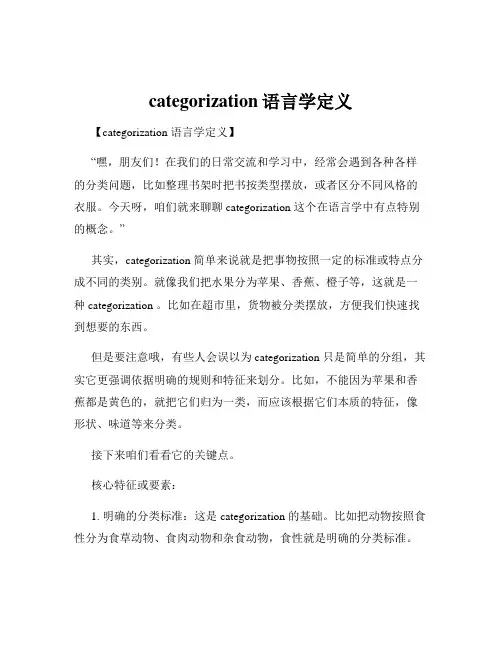
categorization语言学定义【categorization 语言学定义】“嘿,朋友们!在我们的日常交流和学习中,经常会遇到各种各样的分类问题,比如整理书架时把书按类型摆放,或者区分不同风格的衣服。
今天呀,咱们就来聊聊 categorization 这个在语言学中有点特别的概念。
”其实,categorization 简单来说就是把事物按照一定的标准或特点分成不同的类别。
就像我们把水果分为苹果、香蕉、橙子等,这就是一种 categorization 。
比如在超市里,货物被分类摆放,方便我们快速找到想要的东西。
但是要注意哦,有些人会误以为 categorization 只是简单的分组,其实它更强调依据明确的规则和特征来划分。
比如,不能因为苹果和香蕉都是黄色的,就把它们归为一类,而应该根据它们本质的特征,像形状、味道等来分类。
接下来咱们看看它的关键点。
核心特征或要素:1. 明确的分类标准:这是 categorization 的基础。
比如把动物按照食性分为食草动物、食肉动物和杂食动物,食性就是明确的分类标准。
2. 系统性:分类要有条理和逻辑。
像把书籍按照文学、历史、科学等大类,然后再细分,这就是系统性的体现。
3. 可变性:分类不是一成不变的。
随着新事物的出现或者我们对事物认识的深入,分类可能会改变。
比如说以前对于音乐的分类比较简单,现在随着音乐风格的多样化,分类也更加细致和丰富了。
容易混淆的概念:Categorization 和 classification 这两个词很相似,但也有区别。
Categorization 更侧重于基于事物内在的本质特征进行分类,比较细致和深入。
而 classification 则更侧重于从宏观的角度进行大致的分类,相对来说没有那么细致。
比如说在生物学中,对物种的 categorization 会非常详细,考虑到基因、生态等多个方面;而 classification 可能只是简单地分为动物、植物、微生物等大类别。
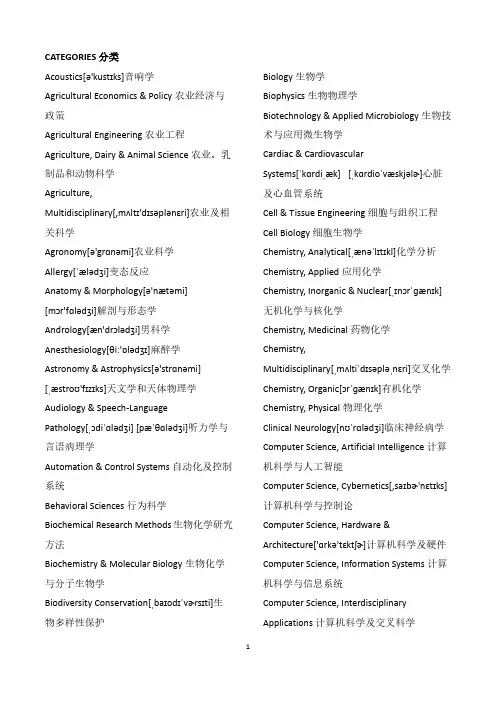
CATEGORIES分类Acoustics[ə'kustɪks]音响学Agricultural Economics & Policy农业经济与政策Agricultural Engineering农业工程Agriculture, Dairy & Animal Science农业、乳制品和动物科学Agriculture,Multidisciplinary[,mʌltɪ'dɪsəplənɛri]农业及相关科学Agronomy[ə'grɑnəmi]农业科学Allergy[ˈælədʒi]变态反应Anatomy & Morphology[ə'nætəmi][mɔr'fɑlədʒi]解剖与形态学Andrology[æn'drɔlədʒi]男科学Anesthesiology[θiː'ɒlədʒɪ]麻醉学Astronomy & Astrophysics[ə'strɑnəmi][ˌæstroʊ'fɪzɪks]天文学和天体物理学Audiology & Speech-LanguagePathology[ˌɔdiˈɑlədʒi][pæˈθɑlədʒi]听力学与言语病理学Automation & Control Systems自动化及控制系统Behavioral Sciences行为科学Biochemical Research Methods生物化学研究方法Biochemistry & Molecular Biology生物化学与分子生物学Biodiversity Conservation[ˌbaɪodɪˈvɚrsɪti]生物多样性保护Biology生物学Biophysics生物物理学Biotechnology & Applied Microbiology生物技术与应用微生物学Cardiac & CardiovascularSystems[ˈkɑrdiˌæk][ˌkɑrdioˈvæskjəlɚ]心脏及心血管系统Cell & Tissue Engineering细胞与组织工程Cell Biology细胞生物学Chemistry, Analytical[ˌænəˈlɪtɪkl]化学分析Chemistry, Applied应用化学Chemistry, Inorganic & Nuclear[ˌɪnɔrˈɡænɪk]无机化学与核化学Chemistry, Medicinal药物化学Chemistry,Multidisciplinary[ˌmʌltiˈdɪsəpləˌnɛri]交叉化学Chemistry, Organic[ɔrˈɡænɪk]有机化学Chemistry, Physical物理化学Clinical Neurology[nʊˈrɑlədʒi]临床神经病学Computer Science, Artificial Intelligence计算机科学与人工智能Computer Science, Cybernetics[,saɪbɚ'nɛtɪks]计算机科学与控制论Computer Science, Hardware &Architecture['ɑrkə'tɛktʃɚ]计算机科学及硬件Computer Science, Information Systems计算机科学与信息系统Computer Science, InterdisciplinaryApplications计算机科学及交叉科学1Computer Science, Software Engineering计算机科学与软件工程Computer Science, Theory & Methods计算机科学理论与方法Construction & Building Technology结构与建筑技术Critical Care Medicine危重症医学Crystallography晶体学Dentistry, Oral Surgery & Medicine牙科,口腔外科与医学Dermatology[,dɝmə'tɑlədʒi]皮肤病学Developmental Biology发育生物学Ecology生态学Education, Scientific Disciplines教育,科学学科Electrochemistry电化学Emergency Medicine急救医学Endocrinology &Metabolism[,ɛndokrə'nɑlədʒi][mɛ'tæbəlɪzəm]内分泌与代谢Energy & Fuels能源与燃料Engineering, Aerospace航空航天工程Engineering, Biomedical生物医学工程Engineering, Chemical化学工程Engineering, Civil['sɪvl]民用工程Engineering, Electrical & Electronic电气与电子工程Engineering, Environmental环境工程Engineering, Geological地质工程Engineering, Industrial工业工程Engineering, Manufacturing制造业工程Engineering, Marine船舶工程Engineering, Mechanical机械工程Engineering, Multidisciplinary多学科工程Engineering, Ocean海洋工程Engineering, Petroleum[pə'trolɪəm]石油工程Entomology[,ɛntə'mɑlədʒi]昆虫学Environmental Sciences环境科学Evolutionary Biology进化生物学Fisheries渔业Food Science & Technology食品科学与技术Forestry林学Gastroenterology & Hepatolog胃肠病学及肝脏病学Genetics & Heredity基因与遗传学Geochemistry & Geophysics地球化学和地球物理学Geography, Physical地理与物理Geology地质学Geosciences, Multidisciplinary多学科性地球科学Geriatrics & Gerontology[,dʒɛrɪ'ætrɪks][,dʒɛrən'tɑlədʒi] 老年病学Health Care Sciences & Services医学保健科学与服务Hematology[,himə'tɑlədʒi]血液学History & Philosophy Of Science历史和科学哲学Horticulture['hɔrtɪ'kʌltʃɚ] 园艺学Imaging Science & Photographic Technology 成像科学与摄影技术Immunology[,ɪmju'nɑlədʒi] 免疫学Infectious Diseases传染病学Instruments & Instrumentation仪器及仪表学Integrative & Complementary Medicine Limnology[lɪm'nɑlədʒi] 湖沼生物学Logic逻辑学Marine & Freshwater Biology海洋和淡水生物学Materials Science, Biomaterials材料科学,生物材料Materials Science, Ceramics[sə'ræmɪks] 材料科学,制陶业Materials Science, Characterization & Testing 材料科学,表征和测试Materials Science, Coatings & Films材料科学,涂料与薄膜Materials Science, Composites[kəm'pɑzɪt]材料科学,复合材料Materials Science, Multidisciplinary材料科学,多学科Materials Science, Paper & Wood材料科学、纸张和木材Materials Science, Textiles['tekstaɪl] 材料科学、纺织品Mathematical & Computational Biology数学与计算生物学Mathematics数学Mathematics, Applied应用数学Mathematics, Interdisciplinary Applications数学,跨学科的应用Mechanics[mə'kænɪks]力学Medical Ethics[‘ɛθɪks]医学伦理学Medical Informatics 医学信息学Medical Laboratory Technology医学实验室技术Medicine, General & Internal普通内科学Medicine, Legal法医学Medicine, Research & Experimental医学研究与实验Metallurgy & MetallurgicalEngineering['mɛtəlɝdʒi]冶金和冶金工程Meteorology & Atmospheric Sciences[,miːtɪə'rɒlədʒɪ] [,ætməs'fɛrɪk] 气象学和大气科学Microbiology微生物学Microscopy显微镜学Mineralogy[,mɪnə'rælədʒi]矿物学Mining & Mineral Processing矿业和矿物加工Multidisciplinary Sciences多学科科学Mycology[maɪ'kɑlədʒi]真菌学Nanoscience & Nanotechnology纳米科技nano['næno]Neuroimaging神经影像Neurosciences神经科学Nuclear Science & Technology核科学与技术Nursing护理Nutrition & Dietetics[daɪə'tetɪks]营养与饮食学Obstetrics & Gynecology[əb'stɛtrɪks][,gaɪnə'kɑlədʒi] 产科学与妇科学Oceanography海洋学Oncology[ɑn'kɑlədʒi]肿瘤学Operations Research & Management Science运筹与管理科学Ophthalmology [,ɑfθæl'mɑlədʒi]眼科学Optics['ɑptɪks]光学Ornithology[,ɔrnɪ'θɑlədʒi]鸟类学Orthopedics[,ɔrθə'pidɪks]矫形术Otorhinolaryngology[,oto,raɪno,lærɪŋ'ɡɑlədʒi]耳鼻喉科学Paleontology[,pelɪɑn'tɑlədʒi]古生物学Parasitology [,pærəsaɪ'tɑlədʒi] 寄生虫学Pathology [pə'θɑlədʒi] 病理学Pediatrics[,pidi'ætrɪks]小儿科Peripheral Vascular Disease[pə'rɪfərəl]['væskjəlɚ]周围性血管疾病Pharmacology & Pharmacy[,fɑrmə'kɑlədʒədʒi] ['fɑrməsi] 药理学Physics, Applied应用物理学Physics, Atomic, Molecular & Chemical物理、原子、分子和化学Physics, Condensed Matter[kən'dɛnst]凝聚态物理Physics, Fluids & Plasmas['plæzmə]流体和等离子体物理Physics, Mathematical数学物理Physics, Multidisciplinary多学科物理Physics, Nuclear核物理Physics, Particles & Fields物理,粒子和场Physiology生理学Plant Sciences植物学Polymer Science['pɑlɪmɚ]高分子科学Primary Health Care初级保健护理Psychiatry[saɪ'kaɪətri]精神病学Psychology心理学Public, Environmental & Occupational Health 公共卫生、环境和职业健康Radiology, Nuclear Medicine & Medical Imaging放射学、核医学和医学成像Rehabilitation [ˌriːəˌbɪlɪ'teʃn]康复Remote Sensing['sensɪŋ]遥感Reproductive Biology[,riprə'dʌktɪv]生殖生物学Respiratory System呼吸系统Rheumatology[,rumə'tɑlədʒi]风湿病学Robotics[ro'bɑtɪks]机器人学Soil Science土壤科学Spectroscopy [spɛk'trɑskəpi] 光谱学Sport Sciences运动医学Statistics & Probability统计及概率学Substance Abuse物质滥用Surgery外科手术Telecommunications电信学Thermodynamics [,θɝmodaɪ'næmɪks] 热力学Toxicology[,tɑksɪ'kɑlədʒi]毒理学Transplantation移植Transportation Science & Technology运输科学与技术Tropical Medicine热带医学Urology & Nephrology [jʊ'rɑlədʒi][nɪ'frɑlədʒi]泌尿及肾内科学Veterinary Sciences['vɛtərənɛri]兽医学Virology [vaɪ'rɑlədʒi]病毒学Water Resources水资源Zoology动物学。


对事物分类和划分的英语作文英文回答:Categorization and Division of Things.Categorization and division are fundamental cognitive processes that humans use to organize and understand the world around them. Categorization involves grouping similar objects or concepts together, while division involves splitting a larger group into smaller, more specific subsets. Both categorization and division play a crucial role in our ability to make sense of the complex world we live in.One of the most important functions of categorization is that it allows us to quickly and efficiently identify and respond to objects in our environment. When we encounter a new object, our brains automatically compare it to existing categories in our memory. If the object matches a category, we can quickly access the information we havestored about that category and use it to guide our behavior. For example, if we see a dog, we can quickly categorize it as a "dog" and access our knowledge about dogs to know howto interact with it.Division, on the other hand, allows us to break down complex concepts or objects into smaller, more manageable parts. This can help us to understand the structure and organization of things in a more detailed way. For example, if we are studying the human body, we can divide it into smaller parts such as the head, torso, limbs, and organs. This division makes it easier for us to understand the function and interrelationship of the different parts ofthe body.Categorization and division are closely related processes that work together to help us organize and understand the world around us. Categorization allows us to quickly identify and respond to objects, while division allows us to break down complex concepts into smaller, more manageable parts. Both processes are essential for ourability to make sense of the world and to interact with iteffectively.中文回答:事物的分类和划分。
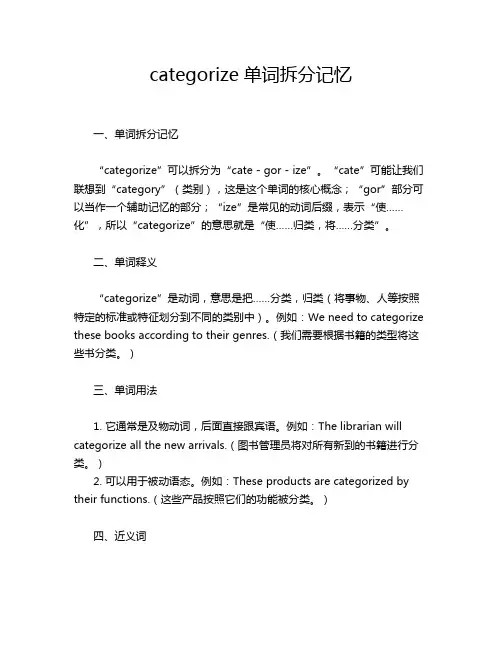
categorize单词拆分记忆一、单词拆分记忆“categorize”可以拆分为“cate - gor - ize”。
“cate”可能让我们联想到“category”(类别),这是这个单词的核心概念;“gor”部分可以当作一个辅助记忆的部分;“ize”是常见的动词后缀,表示“使……化”,所以“categorize”的意思就是“使……归类,将……分类”。
二、单词释义“categorize”是动词,意思是把……分类,归类(将事物、人等按照特定的标准或特征划分到不同的类别中)。
例如:We need to categorize these books according to their genres.(我们需要根据书籍的类型将这些书分类。
)三、单词用法1. 它通常是及物动词,后面直接跟宾语。
例如:The librarian will categorize all the new arrivals.(图书管理员将对所有新到的书籍进行分类。
)2. 可以用于被动语态。
例如:These products are categorized by their functions.(这些产品按照它们的功能被分类。
)四、近义词1. classify:这是和“categorize”最接近的近义词。
例如:Scientists classify animals into different groups.(科学家将动物分类成不同的群组。
)2. group:更强调将事物聚集在一起形成组,虽然有分类的意味,但没有“categorize”那么明确按照特定标准分类。
例如:We group the students by their ages.(我们按照学生的年龄将他们分组。
)3. sort:和“categorize”用法相似,侧重于按照某种顺序或者性质排列。
例如:Sort these papers alphabetically.(按照字母顺序将这些文件分类。
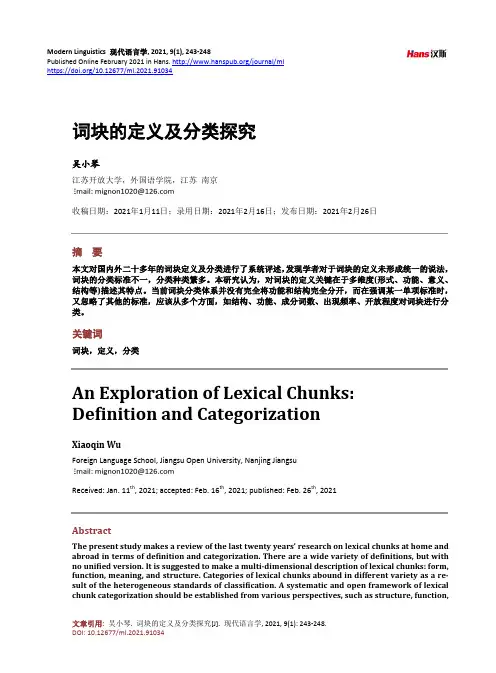
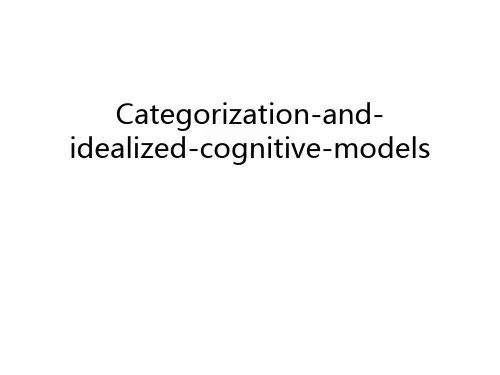
Chapter 6Cognition(概念,选择题)I n psychology, it is used to refer to the mental processes and can be understand as information processing.Another definition of”Cognition”is the mental process or faculty of knowing, including awareness, perception, reasoning and judgment.There are three approaches to the study of language and cognition: the formal approach, the psychological approach, and the conceptual approach.Psycholinguistics(概念,选择题)Psycholinguistics is the study of psychological aspect of language; it is usually studies the psychological states and mental activity associated with the use of language.An important focus of psycholinguistics is the largely unconscious use of grammatical rules that enable people to produce and comprehend intelligible sentences.Psycholinguistics is also concerned with how languages are learned, and the rules they play in our thinking.It is customary to distinguish six subjects of research within Psycholinguistics: Acquisition, Comprehension, Production, Disorder, Language and Thought, Neurocognition.Cognitive Linguistics (名词解释)Cognitive Linguistics is the scientific study of the relation between the way we communicate and the way we think.It’s an approach to language that is based on our experience of the world and the way we perceive and conceptualize it.Construal and Construal Operations (名词解释,三种分类)Construal is the ability to conceive and portray the same situation in alternate ways through specificity, different mental scanning, directionality, vantage point, figure-ground segregation.Construal Operations are conceptualizing processes applied in language process by human beings. That is, construal operations are the underlying psychological processes and resources employed in the interpretation of linguistic expressions.1)Attention/ SalienceThe operations grouped under salience have to do with our direction of attention towards something that salience to us.We activate the most relevant concepts more than concepts that are irrelevant to what we are thinking about.2)Judgment/ComparisonThe Construal Operations of Judgment/Comparison have to do with judging something by comparing it to something else. This is quit a fundamental cognitive capacity and the cognitive operations of judgment are also very fundamental to the human experience.3)Perspective/SituatednessWe view a scene in terms of our situatedness. Perspective generally depends on two things. Firstly, it depends on where we are situated in relation to the scene we are viewing. Secondly, itdepends on how the scene is arranged in relation to our situatedness.Categorization (名词解释、三种分类)Categorization is the process of classifying our experiences into different categories based on commonalities and differences. It is a major ingredient in the creation of human knowledge, and it allows us to relate present experiences to past one.1)Basic levelThe categories at the Basic Level are those that are most culturally salient and are required to fulfill our cognitive needs the most.2)Superordinate levelSuperordinate categories are the most general ones. The members of a superordinate category do not have enough features in common to conjure up a common gestalt at this level.3)Subordinate levelThey have clearly identification gestalts and lots of individual specific features. At this level, we perceive the differences between the members of the basic level categories.Image Schemas (名词解释、各个分类的特点-选择题)Mark Johnson defines an image schema as a recurring, dynamic pattern of our perceptual interactions and motor programs that gives coherence and structure to our experience.1) A center-periphery schema2) A containment schema3) A cycle schema4) A force schema5) A link schema6) A part-whole schema7) A path schema8) A scale schema9) A verticality schemaMetaphor (名词解释)Metaphor involves the comparison of two concepts in that one is construed in terms of the other. It is often described in terms of a target domain and a source domain. The target domain is the experience being described by the metaphor and the source domain is the means that we use in order to describe the experience.1)ontological metaphorsHuman experiences with physical objects provide the basic for ways of viewing events, activities, emotions, ideas, ect, as entities and substances.2)structural metaphorsIt allows us to go beyond orientation and referring and gives us the possibility to structure one concept according to another.3)orientional metaphorsIt gives a concept a spatial orientation. They are characterized not so much by structuring one concept in terms of another, but by a co-occurrence in our experience.Metonymy (名词解释)Metonymy, in the cognitive literature, is defined as a cognitive process in which the vehicle provides mental access to the target within the same domain.Chapter 7Sapir-Whorf Hypothesis (重点-大题)Our language helps mould our way of thinking and consequently, different language may probably express speaker’s unique wayside of understanding the world.Linguistic Determinism, language may determine our thinking patterns.Linguistic Relativity, language is relative in similarity. For two different speech communities, the greater their structural differentiation is, the more diverse their conceptualization of the world will be.Firth-theory of context of situation(重点-大题)1)The relevant features of the participants, persons, personalities.The verbal action of the participants.The non-verbal action of the participants.2)The relevant objects.3)The effects of the verbal action.That is, who speaks what to whomever and when for what.Culture in language teaching classroom(重点-大题)To get the students familiar with culture differences;To help the students transcend their own culture and see things as the members of the target culture will;To emphasize the inseparability of understanding language and understanding culture though various classroom practices.Chapter 8Pragmatic (名词解释)Pragmatic is the study of language in use, focusing on the study of meaning in speaker’s meaning.Speech act theory (名词解释)It was proposed by John Austin in his book How to Do Things with Words. It is a philosophical explanation of the nature of linguistic communication. It aims to answer the question” What do we do when using language?”1.Performatives and Constatives (大题举例子)Performatives are statements which are used to do something, which do not state or describe a fact and not verifiable.Performative verbs: mane, bet, ect.Constatives are statements that state or describe a fact and are thus verifiable.2.Felicity ConditionsThere must be a relevant conventional procedure, and the relevant participants andcircumstances must be appropriate;The procedure must be executed, correctly and completely;Very often, the relevant people must have the requisite thought, feelings and intentions, and must follow it up with actions as specified.A theory of the Illocutionary act (大题)The theory of the illocutionary act was set up by Austin. There are three acts, locutionary act, illocutionary act, perlocutionary act.locutionary act: the act of saying something in the full sense of “say”.Illocutionary act: an act performed in saying something, that is to say something is to do something. It is the act of expressing the speaker’s intention.Perlocutionary act: the act performed by or as a result of saying, the effects on the hearer.Conversational implicature: (大题or名词解释)It is the use of conversational maxims to imply meaning during conversation.in order to avoid the logical use of implication (in the section on logical semantics), Grice coined the term implicature.The characteristics of Conversational implicature:CalculabilityThe fact that speakers try to convey conversation implicature and hearers are able to understand them indicates that implicature are calculable.CancellabilityIf the linguistic or situational contexts change, the implicature will also change.Non- detachabilityIt means that a conversational implicature is attached to the semantic content of what is said, not to the linguistic form. Therefore, it is possible to use a synonym and keep the implicature intact.Non- conventionalityConversational implicature is by definition different from the conversational meaning of words. It is indeterminate and it varies with context.The Cooperative Principle (大题)A speaker can mean more than what is said and the hearer can understand the speaker’s meaning. Grice argues that there is a set of assumption guiding the conduct of conversation. This is what he calls The Cooperative Principle. CP is meant to describe what actually happens in conversation.To specify the CP further, Grice introduced four categories of maxims as follows:Quantity: make your contribution as informative as is required; do not make your contribution more informative than is required.Quality: try to make your contribution one that is true. Do not say what you believe to be false. Do not say that for which you lack adequate evidence.Relation: be relevant.Manner: be perspicuous. (avoid obscurity of expression, avoid ambiguity, be brief, be orderly)Relevance Theory (名词解释)This theory was formally proposed by Dan Sperber and Wilson in their book Relevance, Communication and Cognition in 1986. They believe that all Gricean maxims, including the CP itself, should be reduced to single principle of relevance, which can be define d as: every act of ostensive communication communicates the presumption of its own optimal relevance.Chapter 9(名词解释)Literary StylisticsThe branch of linguistics that studies the relationship between language and literature is Literary Stylistic, which focuses on the study of linguistic features related to literary style.StylisticsStylistics is the study of varieties of language which properties position that language in context.ForegroundingOriginally coming from usual arts and in contrast with back grounding, the concept of foregrounding, a popular term in stylistics, was applied in literary studies by the Prague School, modern stylisticians. It is defined as “artistically motivated deviation”. This deviation, or uncommon usage, involves all levels of language, sound, syntax, meaning, etc.RegisterIn linguistic, a register is a variety of language used for a particular purpose or in a particular social setting.。
Syntactic category句法类包括单词语类和短语语类。
其中单词语类包括实义语类(content category)和功能语类(function category)。
实义语类有名词、动词、形容词、副词和介词。
功能语类有限定词(determiner)、助动词(auxiliary)、代词、标句词(complementizer)和连词(conjunction)。
短语语类包括名词短语NP、动词短语VP、介词短语PP、形容词短语AP和副词短语AdvP。
句法结构的三种表达式:括号加标记,改写规则和树形图。
句子成分间的三种基本结构关系:支配关系、居前关系和管辖关系。
支配(dominance):树形图上,如果节点A的位置高于节点B,且只有沿着树枝向下行才能从A到达B,则节点A支配节点B。
居前(precedence):树形图上,如果节点A居于节点B之左,且两者间互无支配关系,则A 居前于B。
管辖(government):如果节点A是管辖语,且A和B是姐妹节,则节点A管辖节点B。
管辖语为中心语。
论元(argument):谓词所涉及的对象。
每个谓词都有一个论元结构(argument structure)。
论元结构信息既表示谓词所要求的最少论元数量,又表示论元由什么短语语类充当承担。
共有四个语类带有论元结构:动词,名词,形容词和介词,都是实义语类。
注意助动词没有论元结构,不参与题元角色分派。
题元关系(thematic relation):动词与论元之间的语义关系。
题元角色(thematic role):论元承担的角色。
论元结构规定句中的论元和谓词的要求论元必须数量相等。
题元结构(thematic structure)要求谓词给论元分配题元角色。
关于题元角色分派的理论叫做题元理论(theta theory)。
题元准则(theta criterion):每个论元都必须充当一个题元角色,每个题元角色都必须分派给一个论元。
名词解释Language is a system of arbitrary vocal symbols used for human communication.语言是任意的有声符号系统,人们可以借助它来达到交流的目的。
Arbitrariness(任意性): the forms of linguistic signs bear no natural relationship to their meaning 语言符号的形式与意义之间没有必然联系bear(具有)Phoneme(音位): It is a phonological concept, an abstract unit. It refer to the smallest unit of sound which is used to distinguish between words. 是一个音韵学概念,是一个抽象单位,它是用来区分单词的声音的最小单位。
Back-formation(逆构词法)refers to an abnormal type of word-formation where a shorter word is derived by deleting an imagined affix from a longer form already in the language.是构词法中一种不规则的类型,即把一个语言中已经存在的较长单词删去想象中的词缀,由此造出一个较短的单词Coordination (并列关系)is a common syntactic(语法的)pattern in English and other languages formed by grouping together two or more categories of the same type with the help of a conjunction(结合)such as and, but and or .并列是英语以及其他语言中一种常见的句法关系,由同类型的两个或两个以上的范畴,借助连词and,but或者or组合而成。
统计学中categorical在统计学中,categorical是一个重要的概念,它是指非数值型的数据或变量。
这些数据或变量通常是被分类的,包括性别、民族、婚姻状况、职业、教育程度等等。
在本文中,我们将从几个方面详细介绍categorical的定义、特点、应用和分析方法等方面。
一、定义Categorical在中文中的意思是“分类的”,在统计学中,它表示被分类的数据或变量,与连续型或数值型的变量相对。
比如,性别、教育程度、职业等都是categorical数据,它们不能被直接度量或计算,而是要通过分类和统计的方式进行分析和处理。
二、特点与连续型或数值型的变量相比,categorical变量有以下几个特点:1. 非数值型的:categorical变量的值通常不是数值,而是文字、符号、代码等。
2. 分类的:categorical变量的取值是有限的,它们可以被分为若干个类别,如“男”和“女”两个分类。
3. 无序的:categorical变量的取值通常是无序的,如“男”和“女”两个分类没有大小之分。
4. 可以被编码:categorical变量可以被编码为数字,用于存储、处理和分析。
三、应用Categorical变量在统计学中的应用非常广泛,例如:1. 描述性统计:可以用来描述不同类别之间的差异和相似性,如男女在身高和体重上的差异和相似性。
2. 探索性数据分析:可以用来探索变量之间的关系和模式,如教育程度和收入之间的关系和模式。
3. 假设检验:可以用来检验不同类别之间的差异是否显著,如男女在某项测验成绩上的差异是否显著。
4. 回归分析:可以用来建立和预测变量之间的关系,如教育程度和收入的回归方程。
四、分析方法在分析categorical变量时,需要使用不同的技术和方法,如:1. 整体比较:对不同类别之间的整体差异进行比较,如男女的平均身高和体重之间的差异。
2. 单因素ANOVA:用于比较三个或三个以上类别之间的差异,如教育程度和收入之间的差异是否显著。
不同的分类标准Different classification standards are often used in various fields and disciplines to categorize and organize information or objects. These standards help create order and make it easier to understand complex concepts. For example, in biology, organisms are classified based on their physical characteristics, genetic makeup, and evolutionary history. This enables scientists to study and compare different species more effectively.在不同的领域和学科中经常使用不同的分类标准来对信息或对象进行分类和组织。
这些标准有助于创造秩序,并使复杂概念变得更容易理解。
例如,在生物学中,生物体根据其外貌特征、基因组成以及进化历史进行分类。
这使科学家能够更有效地研究和比较不同的物种。
Similarly, in library science, books are often classified using the Dewey Decimal Classification system or the Library of Congress Classification system. These systems help library staff and patrons locate specific books easily and efficiently. By organizing books into categories based on subject matter, authors, or genres, users can quickly find the information they need.同样,在图书馆科学中,图书通常使用杜威十进制分类系统或美国国会图书馆分类系统进行分类。